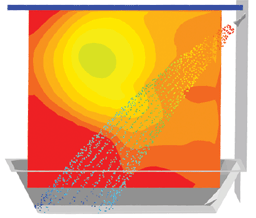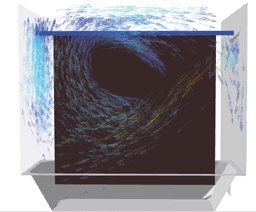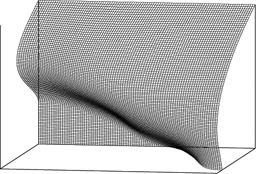Shower Curtains
Shower Curtain Grabs Scientist – But He Lives to Tell Why
Courtesy of David Schmidt, University of Massachusetts
Water droplets in the shower are shown colored by velocity magnitude. Filled contours of pressure are indicated on the shower curtain.
Assistant professor David Schmidt from the University of Massachusetts has been puzzled by the annoying tendency of shower curtains to billow in during a shower and stick to the leg or arm of the person attempting to bathe. An expert in modeling sprays and jet breakup, Schmidt decided to use some of his custom spray models in FLUENT to analyze this conundrum.
Professor Schmidt was a founder of Convergent Thinking LLC, a software firm that models sprays, particularly in turbulent or combusting environments. Convergent Thinking is a Fluent partner, and the spray models are available for use with FLUENT software. Of particular interest is the Taylor analogy breakup, or TAB model, which is used to describe the breakup of a jet into successively smaller drops. Based on an analogy between an oscillating droplet and a forced mass-spring system, the model has been shown to accurately predict experimentally observed jet and drop breakup mechanics.
Longstanding theories have attributed the shower curtain behavior to a combination of two phenomena: the chimney (or buoyancy) effect, and the Bernoulli effect. Because of buoyancy, the heated air inside the shower rises, and cooler air from outside the shower is entrained below the curtain to fill the void left by the rising air. Since the shower curtain has been found to billow even during cold showers, this effect is believed to account only partially for the curtain behavior (or not at all). According to Bernoulli’s equation, the static pressure in a fluid decreases as the fluid velocity increases. Comparing the driven air flow inside the shower (as a result of momentum transfer from the shower spray) with the stagnant air outside, the pressure is lower inside the curtain than outside it. This pressure differential would account for the curtain movement, independent of the temperature of the water.
Velocity vectors show the movement of air in the shower. In addition to the drag-induced motion in the vicinity of the shower, there is a large recirculation pattern above it.
Using the TAB model, Schmidt created a 3D model of his mother-in-law’s shower, where the curtain was well known to exhibit the offending behavior. The coupled flow of water droplets and air in an isothermal environment revealed some surprising results. In particular, the inside air, driven by the shower spray, was found to form a vortex with its axis normal to the plane of the curtain. The low pressure at the center of the vortex, reminiscent of the low pressure at the center of a hurricane, was found to be lower than that caused by the Bernoulli effect alone. While it is cert ainly a combination of the vortex, Bernoulli effect, and buoyancy that lead to t he curtain behavior in a hot shower, Schmidt’s results suggest that the vortex motion is the dominant factor that drives this phenomenon.

The shower curtain deflection shown here (not to scale) was computed using a force balance.
“Until now, it has been one person’s word against another’s,” Schmidt said. “I thought that it would be fun to use FLUENT to say more definitively what the effect was. The air moves in a stable circle just like a dust devil indoors. Unlike a dust devil, however, the shower vortex doesn’t die out because it is continuously driven by the shower. Anyone can test my model. The best way to see it is to turn on the shower – cold water will do fine. Use a light, thin shower curtain and a strong showerhead. Stand outside the shower, stick your head in, and blow in smoke. You will see how the vortex is driven by the water droplets.”
Tip: Original story was published on : www. fluent.com/about/news/newsletters/01v10i2/a8.htm due to unavailability of the story we made it available for our readers here. All the credits goes go respected researchers and we do not claim any involvement




